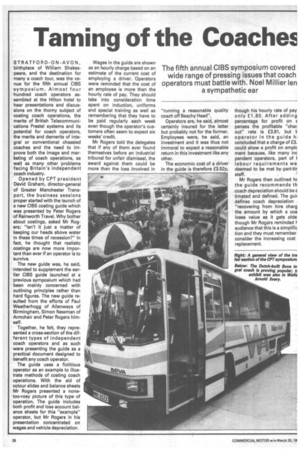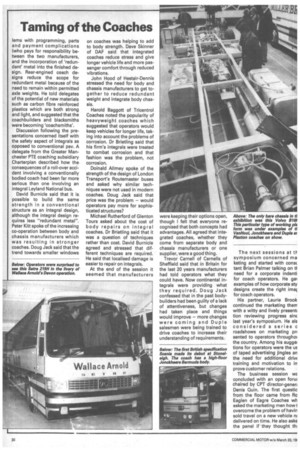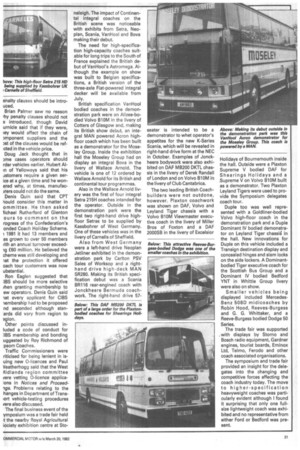Taming of the Coaches
Page 24

Page 25

Page 26

Page 27

If you've noticed an error in this article please click here to report it so we can fix it.
The fifth annual CIBS symposium covered wide range of pressing issues that coach operators must battle with. Noel MiIlier len a sympathetic ear
STRATFORD-ON-AVON, birthplace of William Shakespeare, and the destination for many a coach tour, was the venue for the fifth annual CIBS symposium. Almost four hundred coach operators assembled at the Hilton hotel to hear presentations and discussions on the thorny subject of costing coach operations, the merits of British Telecommunications Prestel systems and its potential for coach operators, the merits and demerits of integral or conventional chassied coaches and the need to improve both the image and marketing of coach operations, as well as many other problems facing Britain's independent coach industry.
Opened by CPT president David Graham, director-general of Greater Manchester Transport, the business sessions proper started with the launch of a new CIBS costing guide which was presented by Peter Rogers of Rainworth Travel. Why bother about costings, asked Mr Rogers; "isn't it just a matter of keeping our heads above water in these times of recession?" In fact, he thought that realistic costings are now more important than ever if an operator is to survive.
The new guide was, he said, intended to supplement the earlier CIBS guide launched at a previous symposium which had been mainly concerned with outlining principles rather than hard figures. The new guide resulted from the efforts of Paul Weatherhogg of Allenways of Birmingham, Simon Newman of Armchair and Peter Rogers himself.
Together, he felt, they represented a cross-section of the different types of independent coach operators and as such were presenting the guide as a practical document designed to benefit any coach operator.
The guide uses a fictitious operator as an example to illustrate methods of costing coach operations. With the aid of colour slides and balance sheets Mr Rogers presented a nonetoo-rosy picture of this type of operation. The guide includes both profit and loss account balance sheets for this "example" operator, but Mr Rogers in his presentation concentrated on wages and vehicle depreciation.
Wages in the guide are shown as an hourly charge based on an estimate of the current cost of employing a driver. Operators were reminded that the cost of an employee is more than the hourly rate of pay. They should take into consideration time spent on induction, uniforms and special training as well as remembering that they have to be paid regularly each week even though the operator's customers often seem to expect six weeks' credit.
Mr Rogers told the delegates that if any of them ever found themselves before an industrial tribunal for unfair dismissal, the award against them could be more than the loss involved in "running a reasonable quality coach off Beachy Head".
Operators are, he said, almost certainly insured for the latter but probably not for the former. Employees were, he said, an investment and it was thus not immoral to expect a reasonable return in this investment like any other.
The economic cost of a driver in the guide is therefore £3.52p,
though his hourly rate of pay only £1.80. After adding percentage for profit on E penses the profitable "char out" rate is £3.91, but t operator in the guide h concluded that a charge of £3. could show a profit on emplc ment because, like many inc pendent operators, part of I labour requirements we deemed to be met by.part-tir staff.
Mr Rogers then outlined Fit the guide recommends th coach depreciation should be E timated and defined. The gui( defines coach depreciation "recovering from hire charg the amount by which a coa loses value as it gets olde though Mr Rors reminded F audience that this is a simplific tion and they must remember consider the increasing cost replacement.
Mr Rogerb suggested a revised definition: "Recovering 'nom hire charges the difference etween the sale or trade-in arice and the replacement /elide cost with no greater aercentage financing or borrowng on the replacement to that ieeded to acquire the original, assuming that the replacement s of an equivalent specification :o the original at the time it was acquired."
When this has been funded :larrectly, he said, it is possible ap change a vehicle for a fleet pack to its original age and specification without any injection of capital. A slide showed the effects of under-provision for lepreciation, but Mr Rogers warned that over-provision can De just 85 devastating.
Examples of the costs of different-aged vehicles and fleets were included to illustrate anaual standing costs for differentaged coaches operating, and these included aspects such as leasing and finance. The axarnples were then incorporated into a chart to show Dperators the amount of revenue required to cover these standing costs and running ?..osts.
In his conclusion, Mr Rogers aointed out that price cutting N85 not in his opinion the most affective form of marketing.
Names that have a reputation built on quality not price have, he said, a habit of going on and on.
During discussions that followed the presentation operators were reminded that the booklet was intended as a guide and not an exact answer for individual operators. Delegates agreed that detailed costings were important and essential although some corn plained of serious and uneconomic undercutting by rival operators.
It was stressed that Traffic Commissioners should be made aware of the costs involved in running a coach and it was suggested that on occasions the information they required of new operators was not as detailed as it should be. The coach industry was said to be in for many shocks as in the past operators had made profits on vehicle trading rather than operating and this was now less possible.
Former Secretary of State for Transport Norman Fowler was quoted at the time of the 1980 Transport Act as looking for "a Laker of the coachways", and it was suggested that perhaps now he will see a lot of "Lakers of the coachways".
The major technical event of the conference was a discussion on the merits of integral coaches or conventional coaches.
From MAN in Germany, Dr Ulrich Brietling described the stiffness and strength of different types of sophisticated modern coach body-structures. The modern integral MAN relies on its strong side walls for rigidity, he said.
From Volvo, Peter Kidd described the merits of mid-engined coaches in achieving better weight distribution between the axles. He stressed that the 810M chassis is a working platform suitable for all different types of body design. He emphasised that as a specialist chassis manufacturer Volvo could offer better service back-up throughout Europe than most integral manufacturers.
He illustrated how his working platform would help operators make money, and showed how body designs could achieve , maximum luggage capacity. He also suggested that the same "working platform" would be suitable as a basis for both double-decker and articulated coachwork. Volvo does believe, however, that its working platform — the chassis and the body — should be welded together to form one integrated vehicle.
Representing Duple Coachbuilders, Doug Jack said that British coachbuilders will now meet continental specifications. In Britain there are and always have been more specialist chassis manufacturers than in Europe where in some countries a lack of chassis had brought about the advent of many European integral coach designs.
He stressed the flexibility of specialist coachbuilders in meeting operator requirements. Duple, he said, offers 50,000 posibilities for specification changes. He noted that the different approach to the coach market adopted by MAN and Bova has apparently been accepted by operators and that demand was also now favouring heavier chassis.
Despite the apparent success of integrals he said that the market still favoured conventional coaches, which in 1982 would out-sell integrals by seven to one. There was no major movement to integrals he said, adding that Duple had already received over 100 orders for its new highfloor Goldliner body. He too spoke of the stability advantage of mid-engined coaches over rear-engined ones and said that rear-engined coaches could more easily be over-loaded on the rear axle.
From Leyland Bus, David Burnicle described how two separate industries, coachbuilding.and blacksmiths, had led to the development of today's coaches. He described how technological advances had led to the development of Monocoque cars and how body and chassis technology had become closer. He outlined some advantages of separate chassis and body manufacture; these included ensuring that all mechanical, hydraulic, pneumatic and electrical systems came from the design of one engineering team, a demarcation break between different skills allowing the same bodies on different chassis, the facility to rebody, and the choice of bodybuilders for the operator.
Disadvantages included prob lems with programming, parts and payment complications (who pays for responsibility between the two manufacturers, and the incorporation of 'redundant' metal into the finished design. Rear-engined coach designs reduce the scope for redundant metal because of the need to remain within permitted axle weights. He told delegates of the potential of new materials such as carbon fibre reinforced plastics which are both strong and light, and suggested that the coachbuilders and blacksmiths were becoming 'coachsmiths'.
Discussion following the presentations concerned itself with the safety aspect of integrals as opposed to conventional psv. A delegate from the Greater Manchester PTE coaching subsidiary Charterplan described how the consequences of a roll-over accident involving a conventionally bodied coach had been far more serious than one involving an integral Leyland National bus.
David Burniele said that it is possible to build the same strength in a conventional structure as an integral design, although the integral design requires less "redundant metal". Peter Kitt spoke of the increasing co-operation between body and chassis manufacturers which was resulting in stronger coaches. Doug Jack said that the trend towards smaller windows on coaches was helping to add to body strength. Dave Skinner of DAF said that integrated coaches reduce stress and give longer vehicle life and more passenger comfort through reduced vibrations.
John Hood of Hestair-Dennis stressed the need for body and chassis manufacturers to get together to reduce redundant weight and integrate body chassis.
Harold Baggot1 of Tricentrol Coaches noted the popularity of heavyweight coaches which suggested that operators would keep vehicles for longer life, taking into account the problems of corrosion. Dr Brietling said that his firm's integrals were treated to combat corrosion and that fashion was the problem, not corrosion.
Doinald Allmey spoke of the strength of the design of London Transport's Routemaster buses and asked why similar techniques were not used in modern coaches. Doug Jack said that price was the problem — would Operators pay more for sophisticated structures?
Michael Rutherford of Glenton Tours asked about the cost of body repairs on integral coaches. Dr Brietling said that it was a question of techniques rather than cost. David Burnicle agreed and stressed that different techniques are required. He said that localised damage is easier to repair on integrals.
At the end of the session it seemed that manufacturers were keeping their options open, though I felt that everyone recognised that both concepts had advantages. All agreed that integrated coaches, whether they come from separate body and chassis manufacturers or one supplier, were a good thing.
Trevor Carnell of Carnells of Sheffield said that in Britain for the last 20 years manufacturers had told operators what they could have. Now continental integrals were providing what they required. Doug Jack confessed that in the past bodybuilders had been guilty of a lack of attentiveness, but changes had taken place and things would improve — more changes were coming and Duple salesmen were being trained to drive coaches to increase their understanding of requirements. The next sessions at th symposium concerned ma keting and started with const tant Brian Palmer talking on ti need for a corporate indenti for coach operators. He gaN examples of how corporate sty designs create the right imat for coach operators.
His partner, Laurie Brook continued the marketing therr with a witty and lively present tion reviewing progress aim last year's symposium. He els considered a series c roadshows on marketing pn sented to operators throughoi the country. Among his sugge tions for operators were the u.E of taped advertising jingles an the need for additional drivl training and motivation to in prove customer relations.
The business session wi concluded with an open forui chaired by CPT director-genen Denis Quin. The first questa from the floor came from Re Eaglen of Eagra Coaches wh asked the marketing men howl overcome the problem of havir sold travel on a new vehicle n4 delivered on time. He also aske the panel if they thought th. enalty clauses should be introuced.
Brian Palmer saw no reason rhy penalty clauses should not a introduced, though David urnicle said that if they were, tey would affect the chain of amponent suppliers and the )st of the clauses would be reficted in the vehicle price.
Doug Jack thought that in
3me cases operators should rder vehicles earlier. Hubert Al
m of Yelloways said that his ustomers require a given earice at a given time and he wonered why, at times, manufacirers could not do the same.
Denis Quin said that CPT hould consider this matter in ommittee. He then asked lichee! Rutherford of Glenton ours to comment on the rogress of the Confederation's • onded Coach Holiday Scheme. 1981 it had 13 members and as grown to over 50 members rith an annual turnover exceed£60 million. He believed the cheme was still developing and 'at the protection it offered oach tour customers was now ubstantial.
Ron Eaglen suggested that :IBS should be more selective /hen granting membership to ew operators. Denis Quin said let every applicant for CIBS lembership had to be proposed nd seconded although stenlards did vary from region to egion.
Other points discussed inluded a code of conduct for
:IBS membership and bonding uggested by Roy Richmond of .psom Coaches.
Traffic Commissioners were riticised for being lenient in is uing new 0-licences and Paul Veatherhogg said that the West Aidlands region committee were vetting 0-licence applica
ions in Notices and Proceedrigs. Problems relating to the
hanges in Department of Transoort vehicle-testing procedures were also discussed.
The final business event of the ymposium was a trade fair held it the nearby Royal Agricultural ;ociety exhibition centre at Sto neleigh. The impact of Continental integral coaches on the British scene was noticeable with exhibits from Setra, Neoplan, Scania, VanHool and Bova making their debut.
The need for high-specification high-capacity coaches suitable for long trips to the South of France explained the British debut of VanHool's Astromega. Although the example on show was built to Belgian specifications, a British version of the three-axle Fiat-powered integral decker will be available from July.
British specification VanHool bodied coaches in the demonstration park were an Alizee-bodied Volvo B1ONI in the livery of Cotters of Glasgow and, making its British show debut, an integral MAN powered Acron highfloor coach which has been built as a demonstrator for the Moseley Group. Inside the exhibition hall the Moseley Group had on display an integral Bova in the livery of Wallace Arnold. The vehicle is one of 12 ordered by Wallace Arnold for its British and continental tour programmes.
Also in the Wallace Arnold livery was the first of four integral Setra 215H coaches intended for the operator. Outside in the demonstration park were the first two right-hand drive highfloor Setras to be supplied by Kassbohrer of West Germany. One of these vehicles was in the livery of Carnells of Sheffield.
Also from West Germany were a left-hand drive Neoplan Jetliner exhibited in the demonstration park by Carlton PSV Sales of Worksop and a righthand drive high-deck MAN SR280. Making its British specification debut was a Scania BR116 rear-engined coach with Jonckheere Bermuda coachwork. The right-hand drive 57
seater is intended to be a demonstrator to whet operator's appetites for the new K-Series Scania, which will be revealed in right-hand drive form at the NEC in October. Examples of Jonckheere bodywork were also exhibited on OAF MB200 DKTL chassis in the livery of Derek Randall of London and on Volvo BlOM in the livery of Club Cantabrica.
The two leading British Coachbuilders were not outdone, however. Flexion coachwork was shown on DAF, Volvo and Leyland Tiger chassis with a Volvo B1OM Viewmaster executive coach in the livery of Miller Bros of Foxton and a OAF 2000SB in the livery of Excelsior Holidays of Bournemouth inside the hall. Outside were a Plaxton Supreme V bodied OAF for Shearings Holidays and a Supreme V on Volvo BlOM built as a demonstrator. Two Plaxton Leyland Tigers were used to provide the Symposium delegates coach tour.
Duple too was well represented with a Goldliner-bodied Volvo high-floor coach in the demonstration park and a Duple Dominant IV bodied demonstra tor on Leyland Tiger chassid in the hall. New innovations for Duple on this vehicle included a Transign destination display and concealed hinges and slam locks on the side lockers. A Dominant bodied Tiger executive coach for the Scottish Bus Group and a Dominant IV bodied Bedford YNT in Whittle Group livery were also on show.
Smaller vehicles being displayed included Mercedes Benz 508D midicoaches by Robin Hood, Reeves-Burgess and G. G. Whittaker, and a Reeve-Burgess bodied Dodge 50 Series.
The trade fair was supported with displays by Storno and Bosch radio equipment, Gardner engines, tourist boards, Eminox Ltd, Telmo, Ferodo and other coach associated organisations.
The symposium and trade fair provided an insight for the dele gates into the changing and competitive forces affecting the coach industry today. The move to higher-specification heavyweight coaches was particularly evident although I found it surprising that only one fullsize lightweight coach was exhibited and no representative from either Ford or Bedford was present.
















































